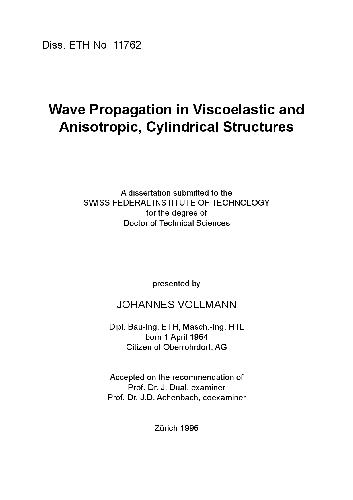Wollmann J.
In this thesis, the complex dispersion relation (frequency versus complex wavenumber) of guided, axisymmetric waves in circular cylindrical structures is investigated theoretically and confirmed by an extended series of experiments. The goal of this work is to understand the topology of the complex wave spectrum for various cylindrical structures, such as elastic shells containing a viscoelastic core, as well as isotropic and anisotropic rods with a circular cross-section in order to determine complex material properties of the structures. In particular, a theoretical model is derived to calculate the complex dispersion relation of axisymmetric wave modes in a thin-walled linear elastic shell containing a viscoelastic core. Curvature and transverse strain cause a coupling between the shell wall bending and longitudinal motion in an empty cylindrical shell. Therefore the dispersion relation of a system consisting of a shell and a viscoelastic core is governed by the shell properties as well as the bulk modulus, the shear modulus, and the density of the core material. By varying the complex moduli, the core can be modelled as an inviscid fluid, an elastic material, or anything between these two extremes.New dynamic metrology is developed to measure complex dispersion relations in a frequency range of between 1 kHz to 2 MHz with up to 40 travelling wave modes in one single process. With a heterodyne LASER interferometer, which was partly developed at the Institute of Mechanics, ETH Zurich, the radial and the longitudinal displacement of the shell surface is detected. The signals are processed with FFT1 in the time domain. To decompose the complex wave-number dependence, a complex total least squares algorithm is used in the space domain. This algorithm, originally developed for the signal processing of NMR2 signals, demands fewer measurements than FFT and allows a lower signal-to-noise ratio. It extracts both the real and the imaginary part of the wavenumber from the measured data.The axisymmetric waves are excited with a radially and a longitudinally-acting piezo transducer simultaneously. Most of the experiments are performed using a steel tube with a diameter of 25 mm and a wall thickness of 0.5 mm. The tubes are filled with water, milk, alcohol, glycerine, silicone oil, and polyisobutylene.Linear elasticity can be considered as an extreme case of viscoelasticity (long relaxation times compared with the deformation cycles). To ascertain the validity of the theory as well as the computational precision, dispersion curves are also calculated for a shell containing a viscoelastic material behaving like the elastic shell. These results are compared with measured curves of an isotropic aluminium rod where excellent agreement was found.In the case of the isotropic aluminium rod, the phenomenon of ‘backward wave propagation’ in which the group velocity and the phase velocity of particular modes have opposite signs, is clearly measured.The method is finally applied in order to determine material properties of anisotropic materials. In this case, the complex dispersion relation of a carbon fibre-reinforced epoxy rod with cylindrical cross-section is measured. The theory presented by Mirsky in 1965 is implemented and the influence of the material constants on the topology of the dispersion relation is discussed numerically. Using the knowledge of the mode shapes at specific locations in the dispersion diagram, the five material parameters describing the dynamic behaviour of transversely isotropic material can be determined step by step with high accuracy. As the imaginary wave-numbers are measured as well, the frequency-dependent damping behaviour of the composite material is discussed on a qualitative basis. | |

Reviews
There are no reviews yet.